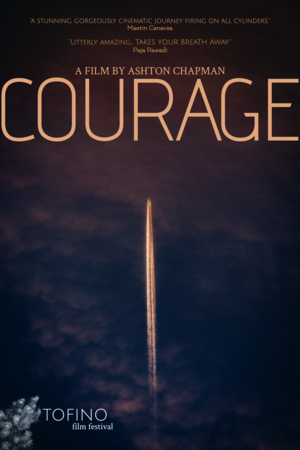Courage (2021)
| Courage | |
|---|---|
 | |
| Directed by | Ashton Chapman |
Running time | 97 minutes |
| Country | Zamastan |
| Language | Caticeze-English |
Courage is a 2021 Zamastanian documentary film edited, written, and produced by Ashton Chapman. It focuses on the history of the Zamastanian Space Agency, the Blue Falcon Moon landings, the construction of the Coalition Space Station, and the Courage program culminating in the first manned-interplanetary flight. The film consists solely of archival footage, including 70 mm film previously unreleased to the public, and does not feature narration, interviews or modern recreations. The film premiered at the 95th Tofino Film Festival on July 5th, 2021.
Synopsis
At the beginning of the World War in 1950, Drambenburg launches the first ever satellite into space. The Zamastanian government is concerned about the progression of scientific advancements of possible adversaries, and despite the Drambenburgian defeat in the war in 1954, they continue to launch satellites into orbit well into the late 50s.
Zamastan gains an edge in the space race on August 6th, 1957, when the first long-term satellite, Cyan-1, was launch into space. In 1958, the ZSA is founded. More victories followed in June 6th, 1962, when the Marri-1 launch put the first Zamastanian astronauts, Casey Giverston and Demarcus Free, into space.
A setback occured in 1970 when a joint-Beleroskov and Drambenburgian rover was landed on the moon, but ultimately Zamastan claimed victory in the space race on June 3rd, 1972, when they became the first country to land humans on the Moon, with Blue Falcon 3 and astronauts John Bennett, Vincent Steward, and Edward Wood Chambers being the first to walk on the lunar surface.
The Coalition of Crown Albatross' founding in 1975 leads to greater international cooperation, and the space race dies down with most attention being paid to understanding space and the wider universe. In the early 90s, with international cooperation, the ZSA leads the mission to build a habitat for humans in orbit. The first modules of the Coalition Space Station were launched from Tregueux International Space Center in Tregueux on October 11, 2004. The final modules, a pair of solar panel systems, were installed on May 31st, 2020, completing the station's construction fully. The space station can house upwards of 10 astronauts at a time, and serves as a microgravity and space environment research laboratory in which scientific experiments are conducted in astrobiology, astronomy, meteorology, physics, and other fields. The station is suited for testing the spacecraft systems and equipment required for possible future long-duration missions to the Moon and other planets.
Since the early 2000s, ZSA had worked on numerous projects designed to test human limitations on the surface of other planets for possible habitation and colonization. The concept operates through three distinct phases leading up to fully sustained colonization. Zamastan has several robotic missions currently exploring Eirus, with a sample-return planned for the future. The Albatross Multi-Purpose Crew Vehicle (MPCV) is intended to serve as the launch/splashdown crew delivery vehicle, with a Deep Space Habitat module providing additional living-space for the 16-month-long journey.
The first stage, already underway, is the "Iearth Reliant" phase. This phase continues using the Coalition Space Station until 2026; validating deep space technologies and studying the effects of long-duration space missions on the human body. The second stage, "Proving Ground," moves away from Iearth reliance and ventures into cislunar space for most of its tasks. The stage would test deep-space habitation facilities, and validate capabilities required for human exploration of Eirus. Finally, phase three is the transition to independence from Iearth resources. The "Iearth Independent" phase includes long term missions with surface habitats that only require routine maintenance, and the harvesting of Eirusian resources for fuel, water, and building materials.
On December 27th, 2020, ZSA Director Thibault Berger and Secretary of Space Science, Development, and Exploration Piyush Goyal announced that the Zamastanian Space Agency would be leading an internationally organized manned-mission to Eirus, the fourth planet in the Estrella System, in the goal of setting up a long term habitation and colonization program on its surface. The mission, named the Courage program, consistent of 16 astronauts (6 Zamastanian, the remaining 10 from Durnstaal, Vitosium, Caspia, Yuan, and Avergnon), is launched on June 5th, 2021, and will arrive at Eirus in January 2022.